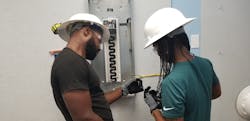If you ever plan to become a foreman or a licensed master electrician, your skill set must include the ability to layout a job from conception. An important step in this process is learning how to design and size service feeder conductors. Let’s take a closer look at the steps involved in this important task.
Service feeder conductors
Dwelling unit (residential) service calculations include, but are not limited to, branch circuits for lighting loads, general-purpose receptacles, small appliances, utilization equipment, fixed appliances, and electric clothes dryers. Nonresidential commercial building service calculations include, but are not limited to, HVAC equipment, cooking equipment, generators, refrigeration equipment, metering equipment, motors, lighting systems, and fire pumps.
Here’s an example of a typical electrical license test question using the “standard” calculation method. There’s also an optional method for calculations; however, most exams only use the standard method. The difference between the two methods is how the demand factor multipliers are applied. The standard method is more conservative, and the optional method is more specific.
Let’s say you have a dwelling unit with 3,000 sq ft of habitable space with laundry facilities and bathrooms, a garage (600 sq ft), and 1,000 sq ft of unfinished habitable space that is adaptable to future use. When calculating the service conductor size for this dwelling unit using the standard calculation method, the minimum demand is _____ volt-amperes.
A. 6,150
B. 7,725
C. 12,000
D. 16,500
To calculate the solution:
• Step 1. Add up the square footage of the entire home, including the basement, because it is considered an “unfinished habitable space that is adaptable to future use.” (Sec. 220.12)
3,000 sq ft + 1,000 sq ft = 4,000 sq ft
• Step 2. Multiply the home's square footage by 3VA to find the minimum general lighting circuits and general-purpose receptacle circuits load. (Table 220.12)
4,000 sq ft x 3VA = 12,000VA
• Step 3. Add two small-appliance kitchen countertop circuits, each at 1,500VA. [Sec. 220.52(A)]
1,500VA x 2 = 3,000VA
• Step 4. Add one dedicated laundry circuit at 1,500VA. [220.52(B)]
• Step 5. Do not include the 600 sq ft of garage space. This and porch areas are not to be included in the service calculation. (Sec. 220.12)
• Step 6. Calculate the subtotal before demand factors are applied.
12,000VA + 3,000VA + 1,500VA = 16,500VA
• Step 7. Apply Table 220.42 demand factors to the total calculated load. For a dwelling unit, the first 3,000VA is applied at 100% demand. Remember: We apply demand factors because everything on these circuits won't or will not be used at the same time. We factor in a discount rate for actual usage. If we did not apply demand factors to our service calculations, we would waste money, material, and manpower installing grossly oversized electrical services.
3,000VA
• Step 8. Now apply a 35% demand factor to the remaining load.
13,500VA x 35% = 4,725VA
• Step 9. Determine your total load.
3,000VA + 4,725VA = 7,725VA
The correct answer to this question is option B.
Follow my column for more practical how-to articles and tips on electric basics and applying those concepts in the field, especially how to put NEC requirements into practice in real-world settings.
Harold De Loach, a master electrician and electrical trainer/instructor, is the founder of The Academy of Industrial Arts (www.taia-school.com) in Philadelphia. With more than 30 years of experience in the field, he writes regular exclusive content for the E-Train and can be reached at [email protected].
About the Author
Harold De Loach
De Loach is the Director of Education and Training for the Leaders of Electrical License Preparation courses for Philadelphia and The Lehigh Valley (www.necprepclass.com). He is the founder and Director of The Academy of Industrial Arts L.L.C. (www.taia-school.com), a customized electrician training program that provides entry-level electrician training courses, electrical safety classes and customized electrical construction courses. He is trained by the National Center for Construction Education and Research (NCCER). He is a member of The National Society of Collegiate Scholars, the Independent Association of Electrical Inspectors, the Electrical Association of Philadelphia, and the Better Business Bureau.
His level of knowledge affords him to teach entry, intermediate, and master level electricians. Armed with more than 20 years of experience in the electrical, general construction, and real estate development industry, he offers his students and clients several unique skill sets. He has worked as the Head Craft Instructor and Assistant Director of Education at the Apprenticeship Training Center (affectionately known as The ABC School) in Harleysville Pennsylvania for Associated Builders and Contractors (The South-Eastern Pa. Chapter). Prior to Joining ABC, he directed a work-readiness (Re-Entry) Construction Technology program within The Philadelphia Prison System and as an Electrical Technician Program instructor at Kaplan Career Institute (Formerly Thompson institute) in Center City Philadelphia and Franklin Mills. He is available for consultation, private tutoring, speaking engagements, or strategic partnerships that can bolster the number of new electricians entering the industry.


